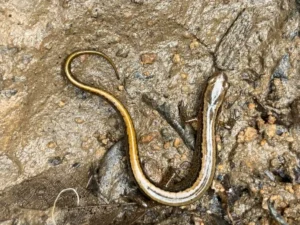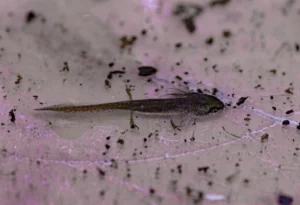Salamanders are secretive amphibians that live quiet lives in forests, streams, and wetlands. They move slowly, stay hidden, and rely on stealth to hunt their prey. Their smooth skin and gentle habits often cause people to wonder more about how they live. One common question is: are salamanders omnivores?
No, salamanders are not omnivores. They are carnivores that eat small animals like insects, worms, snails, and aquatic invertebrates. They do not rely on plants for food and cannot digest vegetation.
What Does It Mean To Be an Omnivore?
An omnivore is an animal that eats both plants and animals as part of its regular diet. Humans are omnivores. So are animals like raccoons, bears, pigs, and many birds. These animals need a combination of plant and animal foods to stay healthy.
To be a true omnivore, an animal must not only eat both types of food, but also gain real nutrition from each.

An animal that swallows a few leaves or fruits by accident is not considered omnivorous unless it depends on both sources.
Salamanders do not meet this definition. They eat only live prey. They do not seek out or digest plants. Their bodies are built for catching prey, not for grazing or chewing plant matter.
What Do Salamanders Eat?
Salamanders eat live prey that they can catch and swallow whole.

Their diet depends on their size, habitat, and species. In general, they eat:
- Insects like ants, beetles, and flies
- Worms, including earthworms and bloodworms
- Snails and slugs
- Spiders, mites, or small crustaceans
- Aquatic invertebrates like water fleas and larvae
- Small amphibians, tadpoles, or even young fish in some cases
Terrestrial salamanders feed on prey found in leaf litter, soil, or under rocks. Aquatic species hunt in ponds, streams, or wetlands. No matter where they live, they all rely on meat-based foods to survive.
They do not nibble on leaves, stems, or fruit. Their food must move, and it must be alive.
Do Salamanders Eat Plants?
No, salamanders do not eat plants. Their digestive systems are not equipped to break down plant fibers like cellulose. Even if they accidentally swallow bits of moss or leaves while catching prey, they cannot digest it.
Sometimes a salamander might eat a fly resting on a leaf and take in a small piece of that leaf. But this is not done on purpose, and it offers no nutrition. The plant matter passes through their body without being used.
Even in captivity, salamanders ignore vegetables, fruits, or other plant foods. They show no interest in food that does not move or smell like prey.
How Do Salamanders Hunt?
Salamanders are quiet and patient hunters. Many sit still and wait for prey to wander close. Others move slowly, stalking their target through damp ground or shallow water.
When the moment is right, they strike. Some use a sticky tongue to grab small insects. Others lunge forward and catch prey in their mouths using suction feeding, opening their mouths quickly to pull in water and anything inside it.
They rely on movement to trigger a feeding response. If something does not move, they usually ignore it.
Salamanders are not grazers or foragers. They are ambush predators.
Do Salamander Larvae Eat Plants?
Even as larvae, salamanders are carnivorous. From the moment they hatch, they feed on tiny aquatic animals such as:
- Plankton
- Small worms
- Water fleas
- Mosquito larvae
- Tiny crustaceans
They grow quickly and need protein to support their development. Like adults, they do not eat or digest plant matter.

They begin life as meat-eaters, and they remain that way.
Are Any Salamanders Omnivores?
No species of salamander is truly omnivorous. While it is possible for one to accidentally swallow some plant matter, none of them intentionally eat plants or rely on vegetation for survival.
They have not evolved to digest or use plants for nutrition. Their biology is focused on protein-rich prey. In fact, some salamanders are known to eat smaller members of their own species in crowded or stressful conditions.
This shows just how meat-focused their diets really are. Cannibalism may seem extreme, but it is another form of carnivory, not omnivory.
Why Don’t Salamanders Eat Plants?
Salamanders avoid eating plants for several important reasons:
- They do not produce enzymes that break down plant fiber
- Their digestive tracts are short and built for digesting meat
- Their instincts tell them to hunt living, moving prey
- Their habitats provide enough animal food to meet their needs
Even in moist environments filled with plants, salamanders pass by leaves, moss, or stems without interest. They do not chew or graze. They wait, watch, and strike.
They are not general feeders. They are specialized hunters.
What About Other Amphibians?
Salamanders are part of a larger group of animals called amphibians. Some amphibians have more varied diets at different life stages, but omnivory is still rare.
For example:
- Tadpoles often eat algae or tiny plant matter before growing legs
- Some frogs may eat fruit or seeds in rare cases
Even so, most adult amphibians are insectivores or carnivores. And salamanders are among the strictest meat-eaters in this group.
They never shift from eating plants to animals. From the beginning of life to the end, salamanders hunt for live food.
What Do Pet Salamanders Eat?
Pet salamanders eat the same kinds of food as wild salamanders. They need live prey, such as:
- Earthworms
- Crickets
- Mealworms or waxworms
- Bloodworms or blackworms (for aquatic types)
- Daphnia, brine shrimp, or mosquito larvae (for larvae)
Some pet owners dust the food with calcium or vitamins to make sure their salamander stays healthy. But the food must still be alive or freshly killed. Dead insects may sometimes be accepted, but they are less appealing.
Adult salamanders only need to be fed two or three times a week, typically at nighttime. Salamanders will not touch vegetables, fruit, or processed pellets. Their food must crawl, wriggle, or swim.
Can You Feed a Salamander Vegetables?
No, salamanders should not be given vegetables or fruits. These foods have no value for them. They do not recognize them as food, and even if they are swallowed, they are not digested properly.
In the worst case, plant matter could cause stomach trouble or blockages. In the best case, it will pass through without harm. But either way, it is not useful.
The safest way to feed a salamander is to offer live prey that matches its size and species.
What Happens If a Salamander Eats a Plant?
If a salamander accidentally eats a bit of moss or leaf while hunting, it is usually not a problem. The plant matter will pass through its body without being digested.
But if a salamander in captivity keeps eating plant material, it could suffer from malnutrition. Without protein, it cannot stay healthy. Its body needs nutrients found only in animal prey.
Feeding plants to a carnivore cannot meet its needs. A healthy salamander requires a steady diet of live food.
Conclusion
So, are salamanders omnivores?
No, salamanders are carnivores that feed on insects, worms, and other small animals. They do not eat or digest plants, and they do not benefit from fruits, vegetables, or leaves.
Their bodies are adapted for protein-rich food, and their instincts drive them to hunt. From larvae to adults, salamanders rely on live prey to grow and survive.
Their quiet, careful lives may seem simple, but their feeding habits show how well they are suited to their environment. By learning what salamanders eat, we better understand how they live, and how we can care for them safely in the wild or at home.
Hi, my name is Ezra Mushala, i have been interested animals all my life. I am the main author and editor here at snakeinformer.com.

